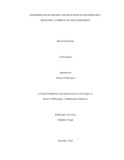
Please use this identifier to cite or link to this item:
https://hdl.handle.net/20.500.14301/358Full metadata record
| DC Field | Value | Language |
|---|---|---|
| dc.contributor.author | Pant, Binod Prasad | - |
| dc.date.accessioned | 2024-02-06T09:15:45Z | - |
| dc.date.available | 2024-02-06T09:15:45Z | - |
| dc.date.issued | 2015-12 | - |
| dc.identifier.citation | Pant,B.P.(2015). Pondering on my beliefs and practices on mathematics, pedagogy, curriculum and assessment. | en_US |
| dc.identifier.uri | https://hdl.handle.net/20.500.14301/358 | - |
| dc.description.abstract | At the time I got into teaching, teaching mathematics was thought to be solving mathematical problems. The deep seated beliefs towards the absolutist nature of mathematics (Lerman, 1986) and the overemphasis on the view as mathematics as a pure subject (Luitel, 2013) in my schooling shaped my teaching to be teacher centered. Till date after I completed my schooling, I have been fortunate to experience as a student and teacher simultaneously. I was busy in identifying the better tricks, tips and techniques to solve mathematical problems to produce good results in national examination in the initial days of my teaching career. I was highly impressed with the view of “Banking Pedagogy” (Freire, 2000). For this, I deposited lots of “money” in the bank and tried my best to have maximum “transaction” among my “clients”. I was also heavily guided by the technical interest as discussed by Habermas (1972). After joining the Bachelor’ degree in Education, I came to know that other pedagogical approaches besides lecture method also existed in the field of teaching. The use of various manipulatives helped to minimize the gap between school ii mathematics and students’ mathematics. “Mathematical problems are to be solved” was the dominating icon for me. At this time, I believe that I shifted towards the practical interest form technical interest. Joining New Age University for my graduate study became a turning point in my professional life. The classroom discourse and the practices about transformative education challenged my beliefs about the nature of mathematics, curricula, pedagogy, assessment, etc. At this moment, I reflected my long journey of teaching and learning mathematics and I thought unfolding my narratives of my professional life would be a milestone to improve my practices for the rest of my career, and the verisimilitude narratives may make my readers thoughtful about their teaching approaches by reflecting on their perceptions and practices regarding mathematics and its pedagogy. In this context, autoethnography was the best research methodology for me. The purpose of my research was to investigate and critically asses my beliefs towards mathematics and mathematics teaching, curriculum and assessment. In order to address this purpose, I devised four research questions and chose multiparadigmatic research design (Taylor, Taylor & Luitel, 2012). Interpretivism allowed me to provide substantial descriptive details that are imperative in contextual understanding (Bryman, 2012). The "outward criticality" as well as "internal criticality" made aware with my own practices and the communal strengths and limitations. The use of postmodernism, here, was to draw the multiple genres to capture the narrative in more pragmatic way. I presented my narratives and discussed from the various perspectives to highlight the shift I made on the beliefs and its consequences on classroom teaching. It provided me an opportunity to critically assess my professional journey and to be aware of the dis/empowering forces that existed within me and the iii surroundings. I assessed my beliefs towards the nature of mathematics and came up with such belief systemthat promotes inclusive nature of mathematics (such as dialogical nature of mathematics, Ernest, 1994; humanistic mathematics, White, 1993; im/pure mathematics, Luitel, 2013, cultural nature of mathematics, D’Ambrosio, 1990, 2015). Then, I reflected on my beliefs towards mathematics curriculum, and came up with inclusive and transformative vision for a mathematics curriculum (such as curriculum as currere, Pinar, 2004; Curriculum as montage, Luitel, 2009; curriculum for ecological sustainability and holistic models, Slattery, 2006) in Nepali context. I, then, unpacked my beliefs and practices towards the pedagogical practices, dominant in the field of mathematics education in Nepal, and landed with the critical pedagogy (such as teaching by relfection, Pesci, 2009; teaching for critical understanding, Giroux, 1983; teaching mathematics for social justice, Gutstein, 2006) as a helpful pedagogy for Nepali society. Finally, I critically investiaged my beliefs and practices towards students’ assessment, andtried to envisage the better assessment practices (such as assessment is to improve performances, Wiliam, 2011; assessment as enabling power, Wyatt-Smith, Klenowski, & Colbert, 2014) that promote assessment as an inseparable and continuous part of teaching and learning. | en_US |
| dc.language.iso | en | en_US |
| dc.publisher | Kathmandu University School of Education | en_US |
| dc.title | Pondering on my Beliefs and Practices on Mathematics, Pedagogy, Curriculum and Assessment | en_US |
| dc.type | Dissertation | en_US |
| local.school.name | SOED | en_US |
| local.school.department | DOSE | en_US |
| local.school.program | MPhil in STEAM Educaiton | en_US |
| local.school.level | M.Phil. | en_US |
| Appears in Collections: | Dissertation | |
Files in This Item:
| File | Description | Size | Format | |
|---|---|---|---|---|
| M Phil Thesis_Binod Pd. Pant_Final.pdf | 2.81 MB | Adobe PDF |  View/Open |
Items in DSpace are protected by copyright, with all rights reserved, unless otherwise indicated.